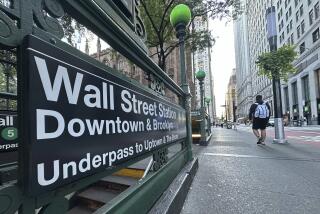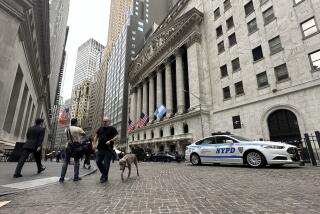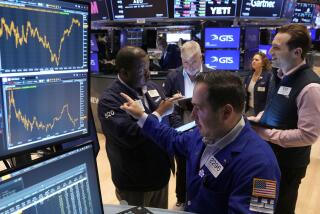Whiplash for stocks may be the new norm
Reporting from New York — Wall Street’s gut-wrenching turbulence in the last six trading days has sent many investors into a state of paralysis, watching helplessly as the Dow Jones industrial average swoons 520 points one day only to soar 430 the next.
Many American’s can’t help but make the comparisons to the financial crisis of 2008. This kind of whipsaw stock trading triggers panic and torpedoes confidence, leading many to abandon stocks altogether.
The Dow roared 423 points higher Thursday to 11,143.31 — the 11th-largest gain in the blue-chip index’s history. It follows a 634-point plunge Monday and a 519-point drop Wednesday, the Dow’s sixth- and ninth-largest by points. But on Tuesday, the Dow soared 429 points.
Each day of this week has seen the Dow Jones industrial average swing at least 400 points, something that happened on only one day in all of 2010.
The question on the minds of everyone from seasoned traders to average Americans: Is this the new normal? At least for the time being, many on Wall Street say it is.
“There are times in life you just have to put on a hard hat, hunker down and just grin and bear it,” said Don Hays, the founder of Hays Advisor.
The volatility was evident this week as the so-called VIX volatility index, known as Wall Street’s fear gauge, rose to levels last seen in the midst of the financial crisis. Some of the panicked selling is surely a result of memories of 2008, when the near-collapse of major banks left many investors with an instinct to get out as soon as possible.
“People are afraid of things that could happen rather than things that have already occurred,” said Adam Sussman, the director of research at Tabb Group, a financial data company.
The recent gyrations have only redoubled Chris McMullen’s decision to keep his money out of the stock market.
“I’m doing the same thing right now anyone else with a brain is doing, leaving it in cash, definitely not the stock market or the real estate market,” said McMullen, who owns a Los Angeles nutritional supplement company.
The current market mayhem was kicked off by concerns about a wide range of economic problems, including seemingly intractable unemployment in the U.S., political paralysis in Washington, continuing weakness in the financial system and over-extended European governments.
The sheer number of moving parts that investors are trying to keep their eyes on has made it hard to stay focused on any one problem.
“There’s no real center for investors to look at,” said A.C. Moore, the chief investment strategist for Dunvegan Associates. “Currently there are extremes all over the world.”
The uncertainty is preyed upon by the so-called high-frequency traders who can buy and sell stocks thousands of times a minute based on computer-programmed algorithms. These traders get particularly involved when stocks are moving quickly to take advantage of rapid price changes, amplifying them in the process.
High-frequency traders can account for 60% of all stock trading during tumultuous market conditions like those seen in the past week, according to Tabb Group.
This can be frustrating for old-fashioned traders such as Ted Weisberg, who stood in disbelief on the floor of the New York Stock Exchange after the Federal Reserve’s announcement on the economy and interest rates Tuesday. The Dow bounced up 100 points, then fell 400 points, and then roared back more than 600 points — all within an hour and a half.
“I guess it’s terrific if you are clever enough and smart enough to take advantage of the changes,” said Weisberg, of Seaport Securities. “But the reality is, this is not the average investor. This is all algorithms.”
Experts are divided on how long this could all last. In 2008, fears spun out of control after Lehman Bros. declared bankruptcy, sending the VIX to levels nearly twice what they are now.
Ultimately, stock markets are driven by economic factors such as unemployment and corporate earnings. With many economists now fearing the recovery is in jeopardy of reversing into recession, it may be some time before Wall Street can find its footing again.
“I’d love to tell you it’s going to be all great next week,” said Jeffrey Hirsh, the editor of the Stock Market Almanac. “I think we’re going to be quite choppy and unstable through the fall.”
More to Read
Inside the business of entertainment
The Wide Shot brings you news, analysis and insights on everything from streaming wars to production — and what it all means for the future.
You may occasionally receive promotional content from the Los Angeles Times.










